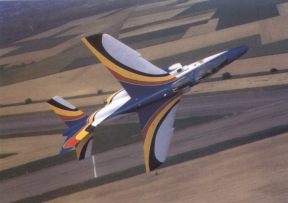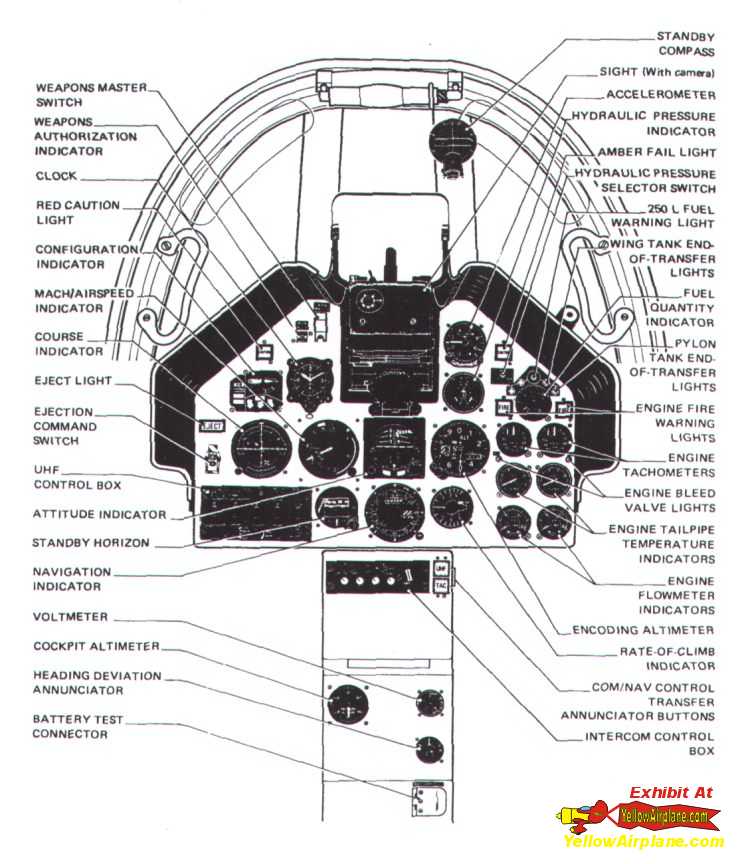|
Airplane
Books * Airplane
Models * Airplane
Movies * Airplane Calendars * Camaros for Sale * Aviation
Exhibits
This is another photo
from the Book
20 years
of Alpha Jet
in the
Belgian Air Force
by Marc Arys
Continue the Alpha Jet Online Exhibit Below
Click on Photo for Larger View
Photo Scanned by C. Jeff
Dyrek
The Alpha Jet Instrument
panel drawing
Continue the Alpha Jet Tour Below
The Alpha Jet used Various Avionics for navigation:
-
TACAN:
Hoffman micro-TACAN, AN/ARN 91B, TACAN stands for Tactical Air
Navigation providing the pilot with Bearing to or from a station, Range
to a station, Ground speed to a station, Air to Air Bearing and Range to
other aircraft for refueling or other rendezvous. In Contrast the
Hoffman TACAN used in the 1970's Vought A-7A/:B Corsair II Attack aircraft
was an AN/ARN-52 Tube type TACAN and the A-7E Corsair II used a digital
AN/ARN-84 TACAN
-
GPS
Global
Positioning System A system using numerous
satellites to give extremely accurate position, altitude, ground speed
and more. Usually has a moving map and data pages.
-
VOR
Visual
Onmidirectional Range: Very similar
to the TACAN information but no Air to Air, Range, or ground speed information.
Frequency ranges in the VHF Range
-
ILS
Instrument Landing System: Provides Glideslope and Localizer
information to the pilot so he can line up on the runway accurately in
any visibility condition.
-
INS
Inertial Navigational System using a Laser Gyroscope instead of the
older spinning mechanical Gyros. Older gyros used a spinning wheel
to measure the inertia resulting from the movement of the airplane
the new Ring Laser Gyros use a phase shift of the light waves traveling
down a fiber optic to measure the movements of the airplane. This
provides the pilot with very accurate position information which is displayed
on a moving map and used by other instruments in the navigation system.
-
HUD Heads
Up Display: Projects Airspeed, Vertical
Speed, Altitude and attitude information along with a variety of other
navigation and weapon system functions onto a sheet of glass directly in
front of the pilots view outside of the front window.
For Communication the Alpha Jet used:
-
UHF
Ultra
High Frequency Radio with frequencies
in the range of 300 MHz to 3 GHz. This is the military band radio.
-
VHF
Very
High Frequency Radio with frequencies
in the range of 30 MHz to 300 MHz This is used as a secondary radio and
also to be able to communicate with Civilian Aircraft and Airports.
The Civilian Aircraft radio frequencies are 118.00 MHz to 137.975 Mhz in
.025 MHz increments. Newer radio types have a slightly higher upper
limit.
-
IFF
Identification
Friend or Foe, which works in conjunction
with the Radar to determine if another aircraft is a friend or an enemy.
The IFF is very much like the civilian transponder, In addition to the
function of telling the pilot if the other plane is an enemy or not the
IFF and Transponder provide the ATC Air Traffic Control with mode C altitude
information, emergency status e.g.. When a pilot enters a code of 7700 means
he is declaring an emergency, 7600 means he has lost his radio communication,
and 7500 means that the aircraft has been hijacked. Other codes such
as 1200 tell the ATC that the aircraft is flying under VFR Visual Flight
Rules. An X pulse is added to the transmitted IFF Data Train without
pilot intervention. The X pulse is present when the aircraft is a
drone or any type of pilotless aircraft meaning after the pilot ejects.
Not Mentioned here are the Weapons Delivery Computer,
ECM Electronics Counter Measures, Chaff Dispensers, Flair Dispensers, Bomb
Sequencers, and the Radar System and more.
You can see that a jet fighter is very complex.
The book shows detailed pictures of every part of this aircraft with close-ups
of each exterior component fully extended. |
Alpha Jet Jet
Fighter Model Airplanes
Alpha Jet
Aircraft Models
|
Why is it important to look at airplanes?
Airplanes, especially
planes like the
P47 thunderbolt show the rapid growth
of technology in the world and in the United States that provided us with
the great freedom that we enjoy today. With this freedom comes responsibility.
The responsibility to learn all we can not only about airplanes or history,
but about technology. Technology is the most important product of
the United States has today. To keep our country on top of the worlds
technology requires us to have the most trained workforce anywhere.
Aviation is important because aviation and aerospace both exhibit the limits
of our technology. If our students learn about aviation they will be able
to understand any field of work.
We must ensure that aviation, airplanes,
aircraft and aerospace are words on all of our children's lips. |
|
Airplanes create dreams.
Dreams of leaving the restriction of a two dimensional world. Dreams
of having freedom to travel anywhere, in any direction at any time and
any distance. Aircraft give us the big advantage to do all of these things
in only a short while. When we dream of airplanes, we lift our heads
to the sky. We feel the pride of having limitless capabilities.
We don't pick up airplanes, airplanes lift us up and our minds are launched
into new horizons. We need airplanes and we need to keep airplanes
in all of our minds. Aviation gives our people an upward mobility
that no other branch of technology can ever do. As long as we feed
our dreams, we have someplace to go.
C. Jeff Dyrek
|
Ref: 4-6-01
Contact the
Webmaster
|



